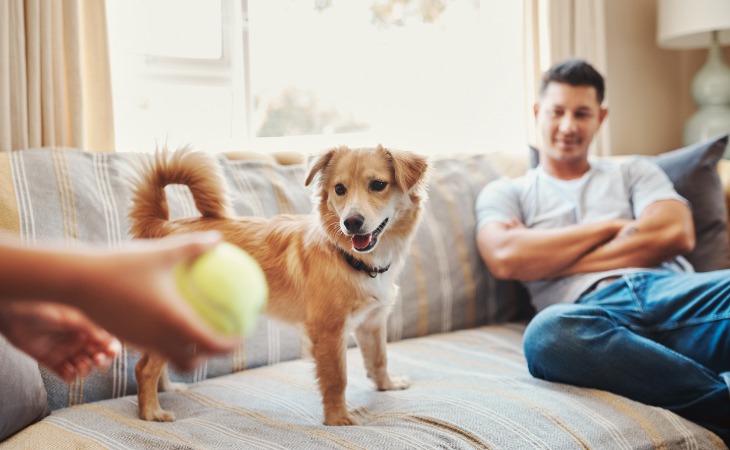Playing with your dog will help you develop a strong bond and share quality time together. It’s also a great way for you and your dog to exercise. One of the easiest games to play is fetch. But to do this, your dog needs to understand how it’s played. To ensure that your dog has fun and isn’t stressed, here are a few steps to teach your dog how to retrieve a toy successfully, calmly, and efficiently. Putting yourself in the right conditions, learning to break down the actions, and being patient will be the keys to spending a good time with your dog playing fetch.
Teaching a dog to fetch a toy
Just like any other training session, it’s important to choose the right place, the right moment, and the right material to use to train your dog. You will make your dog feel a lot more comfortable by following these few basic rules.
Rule #1: find a quiet, enclosed area
This is especially important if you are a training a puppy. It’s best to choose an enclosed area because some dogs might run away while you play with them. It is also recommended to start in a quiet place. The ideal spot should not be too big and always in the same place (at least in the beginning). This way, your dog will associate this area with playing. A few ideal spots could be an enclosed garden or a quiet corner of a public park near your home.
Rule #2: use a toy adapted to your dog’s size and the activity
When teaching your dog to fetch, we recommend using a soft toy that “moves” or bounces. This is because dogs have hunting instincts. When objects move, they tend to think that it is alive. Choosing a toy that moves willl also encourage your dog to play with it. It’s best to stay away from objects and balls that are too hard or too large because they can damage their teeth. They are also more difficult for their small jaws to grasp. The ideal toy to use for fetch is a small soft ball. Other objects that could work are rope objects that heavy enough to be thrown far. You can also choose to use a variety of different toys.
Rule #3: keep treats in your pocket
At least at the beginning, it’s great to use positive reinforcement when you dog succeeds. You can even go all out and give them a triple reward when they succeed in fetching the toy and bringing it back to you — a treat, a caress, and words of encouragement. After some time, you will be able to stop giving treats. The goal is to get your dog to associate the reward with the action he just did a second earlier. You can also keep a pouch with you that is easily accessible so that you can give your dog the treat instantly.
The key to teaching your dog to fetch: break down the actions
To successfully teach your dog how to retrieve a toy, you need to break the action down into several steps:
- be attentive
- follow the object as it is being thrown
- fetch the object
- bring back the object
- give the object back to you
This last step is the most difficult for dogs. Because of this, we suggest that you start the training there.
Fetching and giving back a toy
Dogs do not easily let go of what they hold in their mouths. This simply comes from their instincts of wanting to dominate. The trick is not to get into his “game” by pulling on the object that he is holding. You are the one who controls the rules of the game and you must teach him that.
How do I teach my dog to retrieve a toy?
Here are the different steps to take when training your dog to fetch:
- Get your dog’s attention with their favorite toy and say a simple command like “take”.
- Once your dog has the object in their mouth, hold out your hand in front of them with your palm open and with the other hand offering them a treat. You can use a command like “give”. Your dog will then let go of the toy to be able to eat the treat, you should reward them immediately with a caress. The key here is to show your dog that their action is associated with a reward. You can start with proving a treat and a pat first and as times goes on, you can only give yourself a dog a pat and a comforting word later.
- Practice this “take and give” game with your dog for as long as necessary.
Of course, very few dogs agree to leave their toy at the first attempt. The important thing is to be patient and to vary the objects, the times, the places. This part of the training process can take several weeks. Once your dog has mastered the “take it and give it” command, you can give the commands with more in between them. Most importantly, don’t move on to the next step until this exercise is understood well.

Learning to fetch an object: a must in dog training
The first and most important step is successful: your dog knows how to pick up and drop an object in their mouth. You can now move on to the next step: teaching your dog to retrieve a thrown toy. Chasing a ball, stick, or any other object is usually no problem! To get your dog to play with the object you choose, you just need to get his attention by wiggling it slightly and calling him. A helpful tip: choose an object that you know your dog already likes and then hold it in front of them to get their attention.
If your dog is not interested in the object, do not insist. One of the most difficult aspects is getting your dog to bring back the object. Here is a three-step technique to follow:
- Always associate the action with a clear and simple order like “fetch”. It is important to always use the same command.
- Start by throwing the toy not too far away and wait without moving, standing in the same place. You should reward each success with positive reinforcement. This can be a treat, a pat, or a word of encouragement.
- If your dog is learning through this activity, you can try an alternative called the chase game. First, throw a toy, then get your dog’s attention. Once you have your dog’s attention, throw a second object in another direction. Your dog will run towards the second toy, abandoning the first one. You can then go grab the first object, call your dog over and start again by throwing the the firs toy. After four or five times, call over your dog without throwing the second toy. When your dog passes by you with the first object in their mouth, give the command to let go with the word you have chosen, for examplen “let” or “give” and show them the second toy. Throw the toy only after your dog gives you the first one. After a while, your dog won’t need the second one to bring you the first.
The importance of being patient
When your dog is no longer responsive or you have to leave, do so calmly. This way you are showing them that the game is over for you too. If your dog run away with the object, don’t chase them. Again, they need to understand the rules of the game: it’s about throwing and retrieving the ball, not about you running after them.
To summarize, in order to teach your dog to fetch, you need to be patient and train your dog during short and regular sessions. 10-15 minutes is the ideal amount of time and it is best to do it several times a day. With patience and our advice, this simple game will allow you to bond with your dog and develop a strong friendship.

